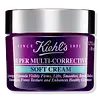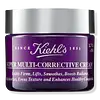What's inside
What's inside
 Key Ingredients
Key Ingredients

 Benefits
Benefits

 Concerns
Concerns

 Ingredients Side-by-side
Ingredients Side-by-side

Water
Skin ConditioningGlycerin
HumectantHydroxypropyl Tetrahydropyrantriol
Skin ConditioningNiacinamide
SmoothingAlcohol Denat.
AntimicrobialDimethicone
EmollientButylene Glycol
HumectantPropylene Glycol
HumectantBetaine
HumectantCoco-Caprylate/Caprate
EmollientSqualane
EmollientCaprylyl Methicone
Skin ConditioningAmmonium Acryloyldimethyltaurate/Vp Copolymer
Hydroxyethylpiperazine Ethane Sulfonic Acid
BufferingInonotus Obliquus Extract
Skin ConditioningAdenosine
Skin ConditioningCapryloyl Glycine
CleansingMenthoxypropanediol
MaskingMethyldihydrojasmonate
MaskingPalmitoyl Tetrapeptide-7
Skin ConditioningPalmitoyl Tripeptide-1
Skin ConditioningSodium Hydroxide
BufferingTetrasodium Glutamate Diacetate
Tocopheryl Acetate
AntioxidantHydrogenated Lecithin
EmulsifyingAcrylates/C10-30 Alkyl Acrylate Crosspolymer
Emulsion StabilisingAluminum Starch Octenylsuccinate
AbsorbentCarbomer
Emulsion StabilisingCetearyl Alcohol
EmollientCetearyl Glucoside
EmulsifyingPolysorbate 20
EmulsifyingSodium Lactate
BufferingT-Butyl Alcohol
PerfumingDimethiconol
EmollientStearyl Dimethicone
EmollientChlorphenesin
AntimicrobialPhenoxyethanol
PreservativeWater, Glycerin, Hydroxypropyl Tetrahydropyrantriol, Niacinamide, Alcohol Denat., Dimethicone, Butylene Glycol, Propylene Glycol, Betaine, Coco-Caprylate/Caprate, Squalane, Caprylyl Methicone, Ammonium Acryloyldimethyltaurate/Vp Copolymer, Hydroxyethylpiperazine Ethane Sulfonic Acid, Inonotus Obliquus Extract, Adenosine, Capryloyl Glycine, Menthoxypropanediol, Methyldihydrojasmonate, Palmitoyl Tetrapeptide-7, Palmitoyl Tripeptide-1, Sodium Hydroxide, Tetrasodium Glutamate Diacetate, Tocopheryl Acetate, Hydrogenated Lecithin, Acrylates/C10-30 Alkyl Acrylate Crosspolymer, Aluminum Starch Octenylsuccinate, Carbomer, Cetearyl Alcohol, Cetearyl Glucoside, Polysorbate 20, Sodium Lactate, T-Butyl Alcohol, Dimethiconol, Stearyl Dimethicone, Chlorphenesin, Phenoxyethanol
Water
Skin ConditioningGlycerin
HumectantDicaprylyl Ether
EmollientButyrospermum Parkii Butter
Skin ConditioningHydroxypropyl Tetrahydropyrantriol
Skin ConditioningIsononyl Isononanoate
EmollientPropylene Glycol
HumectantIsopropyl Isostearate
EmollientCetyl Alcohol
EmollientDimethicone
EmollientBehenyl Alcohol
EmollientCandelilla Cera
EmollientGlyceryl Stearate
EmollientStearic Acid
CleansingHydroxyethylpiperazine Ethane Sulfonic Acid
BufferingPalmitic Acid
EmollientPhenoxyethanol
PreservativeCetearyl Alcohol
EmollientCitric Acid
BufferingCarbomer
Emulsion StabilisingCapryloyl Salicylic Acid
ExfoliatingSodium Hydroxide
BufferingCaprylyl Glycol
EmollientPEG-100 Stearate
Vigna Aconitifolia Seed Extract
Skin ConditioningTocopherol
AntioxidantXanthan Gum
EmulsifyingCetearyl Glucoside
EmulsifyingSodium Cocoyl Glutamate
CleansingSodium Hyaluronate
HumectantDisodium EDTA
Pentylene Glycol
Skin ConditioningJasminum Officinale Flower Extract
MaskingMyristic Acid
CleansingRosmarinus Officinalis Leaf Oil
MaskingAdenosine
Skin ConditioningInonotus Obliquus Extract
Skin ConditioningLimonene
PerfumingLinalool
PerfumingPelargonium Graveolens Flower Oil
MaskingLavandula Angustifolia Oil
MaskingRosa Damascena Flower Oil
MaskingWater, Glycerin, Dicaprylyl Ether, Butyrospermum Parkii Butter, Hydroxypropyl Tetrahydropyrantriol, Isononyl Isononanoate, Propylene Glycol, Isopropyl Isostearate, Cetyl Alcohol, Dimethicone, Behenyl Alcohol, Candelilla Cera, Glyceryl Stearate, Stearic Acid, Hydroxyethylpiperazine Ethane Sulfonic Acid, Palmitic Acid, Phenoxyethanol, Cetearyl Alcohol, Citric Acid, Carbomer, Capryloyl Salicylic Acid, Sodium Hydroxide, Caprylyl Glycol, PEG-100 Stearate, Vigna Aconitifolia Seed Extract, Tocopherol, Xanthan Gum, Cetearyl Glucoside, Sodium Cocoyl Glutamate, Sodium Hyaluronate, Disodium EDTA, Pentylene Glycol, Jasminum Officinale Flower Extract, Myristic Acid, Rosmarinus Officinalis Leaf Oil, Adenosine, Inonotus Obliquus Extract, Limonene, Linalool, Pelargonium Graveolens Flower Oil, Lavandula Angustifolia Oil, Rosa Damascena Flower Oil
Ingredients Explained
These ingredients are found in both products.
Ingredients higher up in an ingredient list are typically present in a larger amount.
Adenosine is in every living organism. It is one of four components in nucleic acids that helps store our DNA.
Adenosine has many benefits when used. These benefits include hydrating the skin, smoothing skin, and reducing wrinkles. Once applied, adenosine increases collagen production. It also helps with improving firmness and tissue repair.
Studies have found adenosine may also help with wound healing.
In skincare products, Adenosine is usually derived from yeast.
Learn more about AdenosineCarbomer is a polymer of acrylic acid. Its main role is to create a gel consistency.
A high amount of carbomer can cause pilling or balling up of products. Don't worry, most products contain 1% or less of carbomer.
Cetearyl alcohol is a mixture of two fatty alcohols: cetyl alcohol and stearyl alcohol. It is mainly used as an emulsifier. Emulsifiers help prevent the separation of oils and products. Due to its composition, it can also be used to thicken a product or help create foam.
Cetearyl alcohol is an emollient. Emollients help soothe and hydrate the skin by trapping moisture.
Studies show Cetearyl alcohol is non-toxic and non-irritating. The FDA allows products labeled "alcohol-free" to have fatty alcohols.
This ingredient is usually derived from plant oils such as palm, vegetable, or coconut oils. There is debate on whether this ingredient will cause acne.
Due to the fatty acid base, this ingredient may not be Malassezia folliculitis safe.
Learn more about Cetearyl AlcoholCetearyl Glucoside is a surfactant and emulsifier. It can be produced from synthetic of natural sources of cetearyl alcohol and glucose.
Emulsifiers help prevent ingredients from separating, such as oils and waters. It can also be used to enhance the texture of products.
As a surfactant, Cetearyl Glucoside helps during the cleansing process. By gathering all the dirt and oils, it allows these molecules to be washed away easily.
Learn more about Cetearyl GlucosideDimethicone is a type of synthetic silicone created from natural materials such as quartz.
What it does:
Dimethicone comes in different viscosities:
Depending on the viscosity, dimethicone has different properties.
Ingredients lists don't always show which type is used, so we recommend reaching out to the brand if you have questions about the viscosity.
This ingredient is unlikely to cause irritation because it does not get absorbed into skin. However, people with silicone allergies should be careful about using this ingredient.
Note: Dimethicone may contribute to pilling. This is because it is not oil or water soluble, so pilling may occur when layered with products. When mixed with heavy oils in a formula, the outcome is also quite greasy.
Learn more about DimethiconeGlycerin is already naturally found in your skin. It helps moisturize and protect your skin.
A study from 2016 found glycerin to be more effective as a humectant than AHAs and hyaluronic acid.
As a humectant, it helps the skin stay hydrated by pulling moisture to your skin. The low molecular weight of glycerin allows it to pull moisture into the deeper layers of your skin.
Hydrated skin improves your skin barrier; Your skin barrier helps protect against irritants and bacteria.
Glycerin has also been found to have antimicrobial and antiviral properties. Due to these properties, glycerin is often used in wound and burn treatments.
In cosmetics, glycerin is usually derived from plants such as soybean or palm. However, it can also be sourced from animals, such as tallow or animal fat.
This ingredient is organic, colorless, odorless, and non-toxic.
Glycerin is the name for this ingredient in American English. British English uses Glycerol/Glycerine.
Learn more about GlycerinWe don't have a description for Hydroxyethylpiperazine Ethane Sulfonic Acid yet.
We don't have a description for Hydroxypropyl Tetrahydropyrantriol yet.
This ingredient is also known as the chaga mushroom. It is a fungus that grows on birch trees.
Phenoxyethanol is a preservative that has germicide, antimicrobial, and aromatic properties. Studies show that phenoxyethanol can prevent microbial growth. By itself, it has a scent that is similar to that of a rose.
It's often used in formulations along with Caprylyl Glycol to preserve the shelf life of products.
Propylene Glycol is an odorless, colorless liquid. As a humectant, it helps skin retain moisture. It also aids in delivering active ingredients.
Another role of this ingredient is preventing a product from melting or freezing. Propylene glycol also adds antimicrobrial properties to a product, elongating product lifespan.
This ingredient is considered an organic alcohol and commonly added into both cosmetics and foods.
Those with sensitive skin or conditions may develop a rash when using this ingredient.
Learn more about Propylene GlycolSodium Hydroxide is also known as lye or caustic soda. It is used to adjust the pH of products; many ingredients require a specific pH to be effective.
In small amounts, sodium hydroxide is considered safe to use. However, large amounts may cause chemical burns due to its high alkaline.
Your skin has a natural pH and acid mantle. This acid mantle helps prevent harmful bacteria from breaking through. The acid mantle also helps keep your skin hydrated.
"Alkaline" refers to a high pH level. A low pH level would be considered acidic.
Learn more about Sodium HydroxideWater. It's the most common cosmetic ingredient of all. You'll usually see it at the top of ingredient lists, meaning that it makes up the largest part of the product.
So why is it so popular? Water most often acts as a solvent - this means that it helps dissolve other ingredients into the formulation.
You'll also recognize water as that liquid we all need to stay alive. If you see this, drink a glass of water. Stay hydrated!
Learn more about Water